wheel SKODA FABIA 2000 1.G / 6Y User Guide
[x] Cancel search | Manufacturer: SKODA, Model Year: 2000, Model line: FABIA, Model: SKODA FABIA 2000 1.G / 6YPages: 86, PDF Size: 3.58 MB
Page 47 of 86
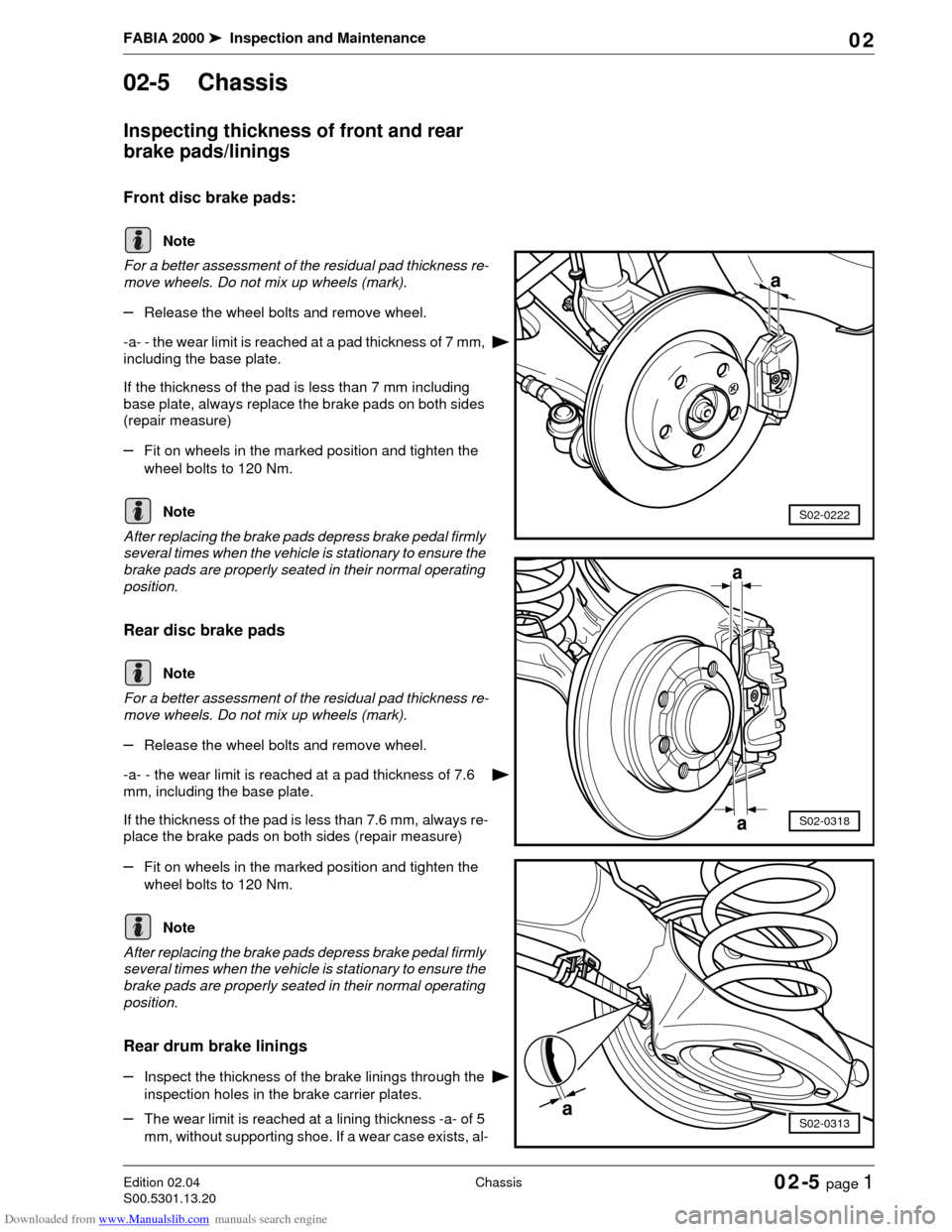
Downloaded from www.Manualslib.com manuals search engine FABIA 2000➤Inspection and Maintenance
ChassisEdition 02.04
S00.5301.13.2002-5 page 1 02
02-5 Chassis
Inspecting thickness of front and rear
brake pads/linings
Front disc brake pads:
For a better assessment of the residual pad thickness re-
move wheels. Do not mix up wheels (mark).
–Release the wheel bolts and remove wheel.
-a- - the wear limit is reached at a pad thickness of 7 mm,
including the base plate.
If the thickness of the pad is less than 7 mm including
base plate, always replace the brake pads on both sides
(repair measure)
–Fit on wheels in the marked position and tighten the
wheel bolts to 120 Nm.
After replacing the brake pads depress brake pedal firmly
several times when the vehicle is stationary to ensure the
brake pads are properly seated in their normal operating
position.
Rear disc brake pads
For a better assessment of the residual pad thickness re-
move wheels. Do not mix up wheels (mark).
–Release the wheel bolts and remove wheel.
-a- - the wear limit is reached at a pad thickness of 7.6
mm, including the base plate.
If the thickness of the pad is less than 7.6 mm, always re-
place the brake pads on both sides (repair measure)
–Fit on wheels in the marked position and tighten the
wheel bolts to 120 Nm.
After replacing the brake pads depress brake pedal firmly
several times when the vehicle is stationary to ensure the
brake pads are properly seated in their normal operating
position.
Rear drum brake linings
–Inspect the thickness of the brake linings through the
inspection holes in the brake carrier plates.
–The wear limit is reached at a lining thickness -a- of 5
mm, without supporting shoe. If a wear case exists, al-
Note
a
S02-0222Note
Note
S02-0318
a
a
Note
S02-0313a
Page 49 of 86
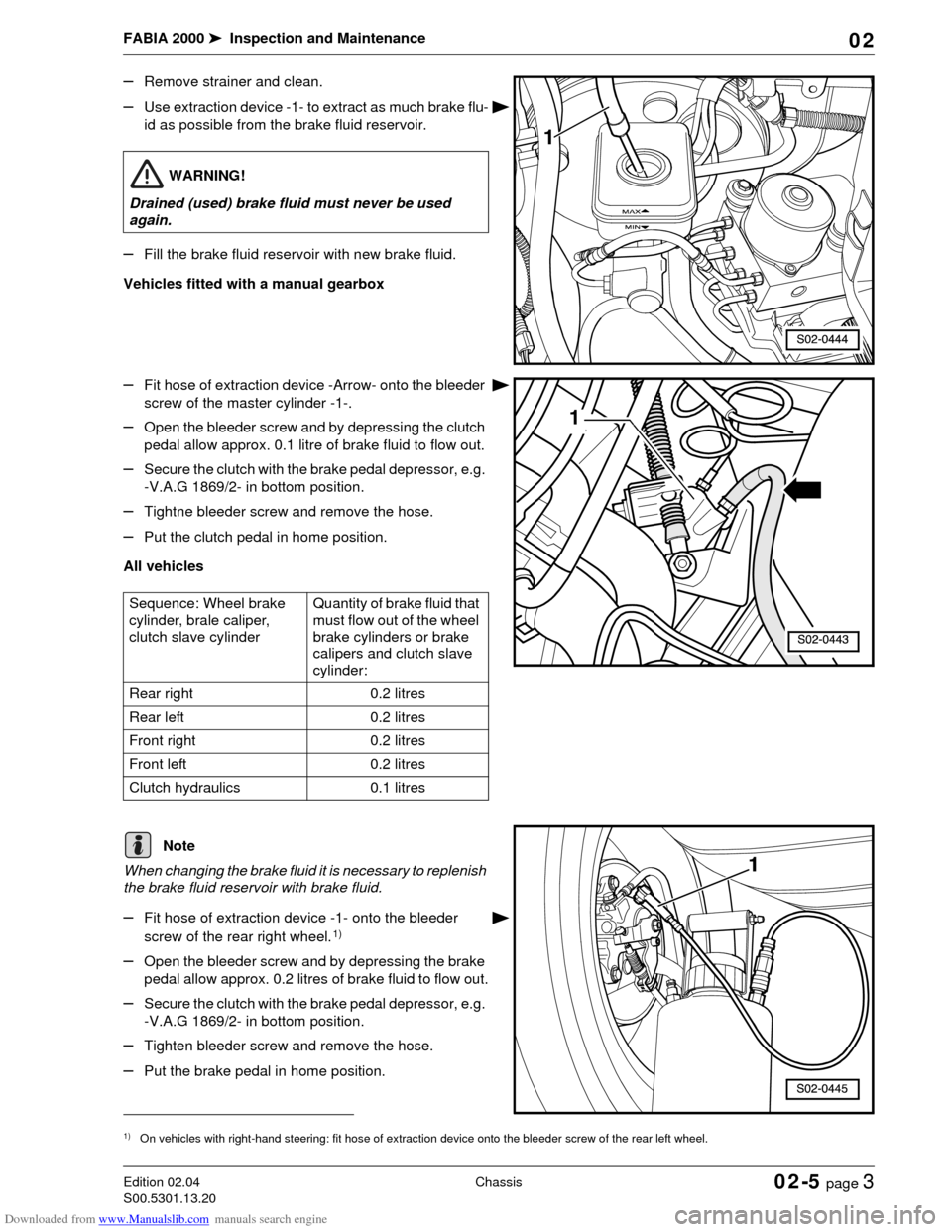
Downloaded from www.Manualslib.com manuals search engine FABIA 2000➤Inspection and Maintenance
ChassisEdition 02.04
S00.5301.13.2002-5 page 3 02
–Remove strainer and clean.
–Use extraction device -1- to extract as much brake flu-
id as possible from the brake fluid reservoir.
–Fill the brake fluid reservoir with new brake fluid.
Vehicles fitted with a manual gearbox
–Fit hose of extraction device -Arrow- onto the bleeder
screw of the master cylinder -1-.
–Open the bleeder screw and by depressing the clutch
pedal allow approx. 0.1 litre of brake fluid to flow out.
–Secure the clutch with the brake pedal depressor, e.g.
-V.A.G 1869/2- in bottom position.
–Tightne bleeder screw and remove the hose.
–Put the clutch pedal in home position.
All vehicles
When changing the brake fluid it is necessary to replenish
the brake fluid reservoir with brake fluid.
–Fit hose of extraction device -1- onto the bleeder
screw of the rear right wheel.
1)
–Open the bleeder screw and by depressing the brake
pedal allow approx. 0.2 litres of brake fluid to flow out.
–Secure the clutch with the brake pedal depressor, e.g.
-V.A.G 1869/2- in bottom position.
–Tighten bleeder screw and remove the hose.
–Put the brake pedal in home position.
WARNING!
Drained (used) brake fluid must never be used
again.
Sequence: Wheel brake
cylinder, brale caliper,
clutch slave cylinderQuantity of brake fluid that
must flow out of the wheel
brake cylinders or brake
calipers and clutch slave
cylinder:
Rear right 0.2 litres
Rear left 0.2 litres
Front right 0.2 litres
Front left 0.2 litres
Clutch hydraulics 0.1 litres
1)On vehicles with right-hand steering: fit hose of extraction device onto the bleeder screw of the rear left wheel.
Note
Page 50 of 86
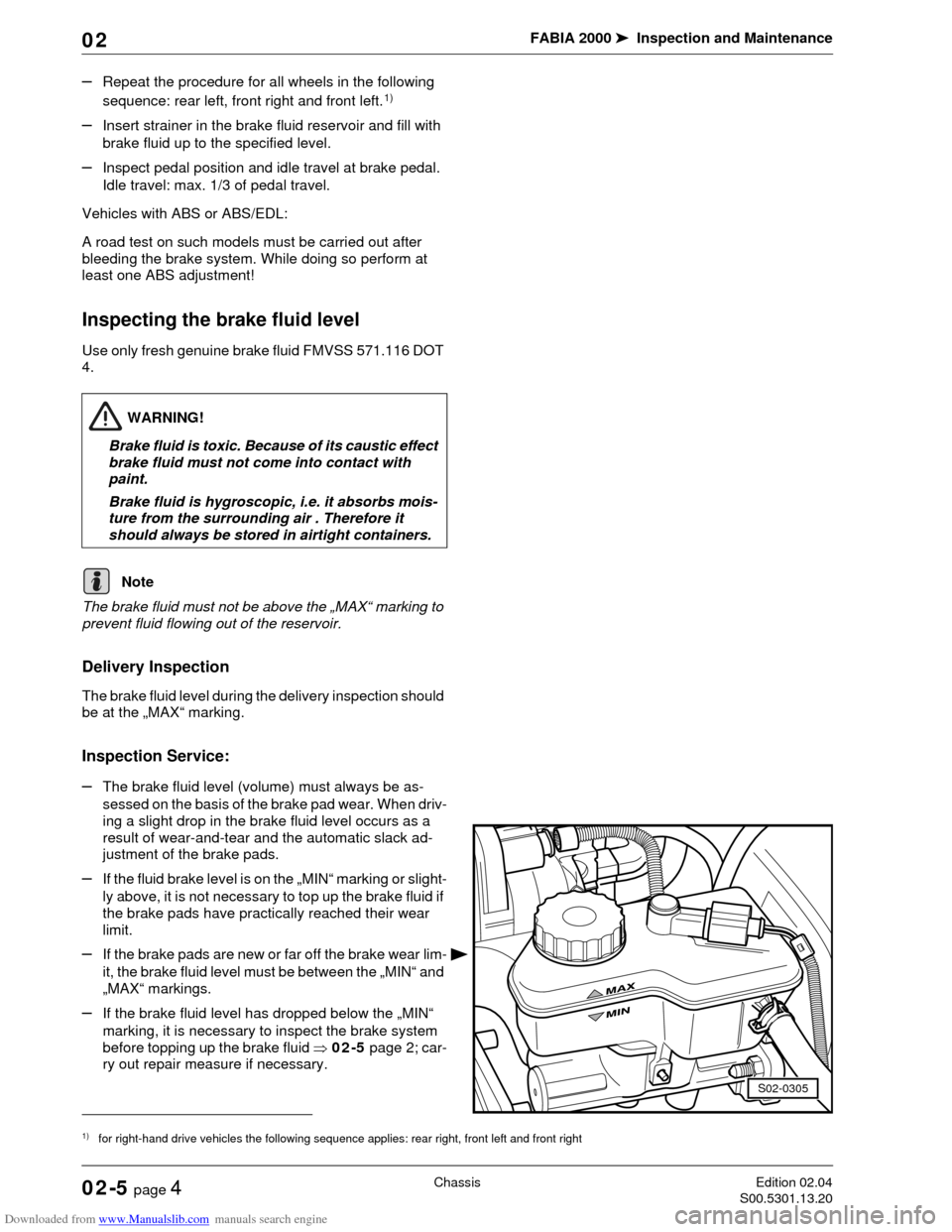
Downloaded from www.Manualslib.com manuals search engine FABIA 2000➤Inspection and Maintenance
ChassisEdition 02.04
S00.5301.13.2002-5 page 4 02
–Repeat the procedure for all wheels in the following
sequence: rear left, front right and front left.
1)
–Insert strainer in the brake fluid reservoir and fill with
brake fluid up to the specified level.
–Inspect pedal position and idle travel at brake pedal.
Idle travel: max. 1/3 of pedal travel.
Vehicles with ABS or ABS/EDL:
A road test on such models must be carried out after
bleeding the brake system. While doing so perform at
least one ABS adjustment!
Inspecting the brake fluid level
Use only fresh genuine brake fluid FMVSS 571.116 DOT
4.
The brake fluid must not be above the „MAX“ marking to
prevent fluid flowing out of the reservoir.
Delivery Inspection
The brake fluid level during the delivery inspection should
be at the „MAX“ marking.
Inspection Service:
–The brake fluid level (volume) must always be as-
sessed on the basis of the brake pad wear. When driv-
ing a slight drop in the brake fluid level occurs as a
result of wear-and-tear and the automatic slack ad-
justment of the brake pads.
–If the fluid brake level is on the „MIN“ marking or slight-
ly above, it is not necessary to top up the brake fluid if
the brake pads have practically reached their wear
limit.
–If the brake pads are new or far off the brake wear lim-
it, the brake fluid level must be between the „MIN“ and
„MAX“ markings.
–If the brake fluid level has dropped below the „MIN“
marking, it is necessary to inspect the brake system
before topping up the brake fluid ⇒02-5 page 2; car-
ry out repair measure if necessary.
1)for right-hand drive vehicles the following sequence applies: rear right, front left and front right
WARNING!
Brake fluid is toxic. Because of its caustic effect
brake fluid must not come into contact with
paint.
Brake fluid is hygroscopic, i.e. it absorbs mois-
ture from the surrounding air . Therefore it
should always be stored in airtight containers.
Note
S02-0305
Page 51 of 86
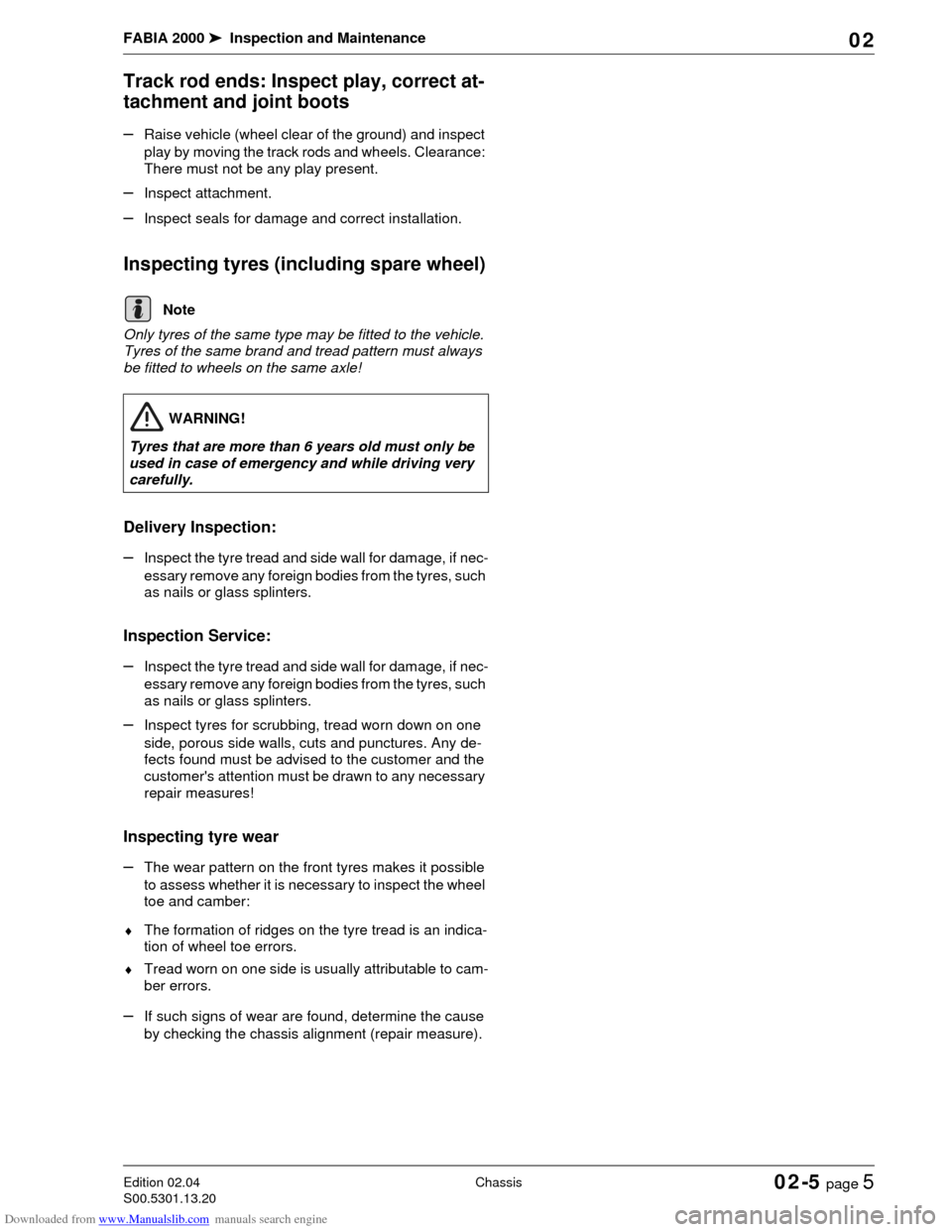
Downloaded from www.Manualslib.com manuals search engine FABIA 2000➤Inspection and Maintenance
ChassisEdition 02.04
S00.5301.13.2002-5 page 5 02
Track rod ends: Inspect play, correct at-
tachment and joint boots
–Raise vehicle (wheel clear of the ground) and inspect
play by moving the track rods and wheels. Clearance:
There must not be any play present.
–Inspect attachment.
–Inspect seals for damage and correct installation.
Inspecting tyres (including spare wheel)
Only tyres of the same type may be fitted to the vehicle.
Tyres of the same brand and tread pattern must always
be fitted to wheels on the same axle!
Delivery Inspection:
–Inspect the tyre tread and side wall for damage, if nec-
essary remove any foreign bodies from the tyres, such
as nails or glass splinters.
Inspection Service:
–Inspect the tyre tread and side wall for damage, if nec-
essary remove any foreign bodies from the tyres, such
as nails or glass splinters.
–Inspect tyres for scrubbing, tread worn down on one
side, porous side walls, cuts and punctures. Any de-
fects found must be advised to the customer and the
customer's attention must be drawn to any necessary
repair measures!
Inspecting tyre wear
–The wear pattern on the front tyres makes it possible
to assess whether it is necessary to inspect the wheel
toe and camber:
♦The formation of ridges on the tyre tread is an indica-
tion of wheel toe errors.
♦Tread worn on one side is usually attributable to cam-
ber errors.
–If such signs of wear are found, determine the cause
by checking the chassis alignment (repair measure).
Note
WARNING!
Tyres that are more than 6 years old must only be
used in case of emergency and while driving very
carefully.
Page 52 of 86
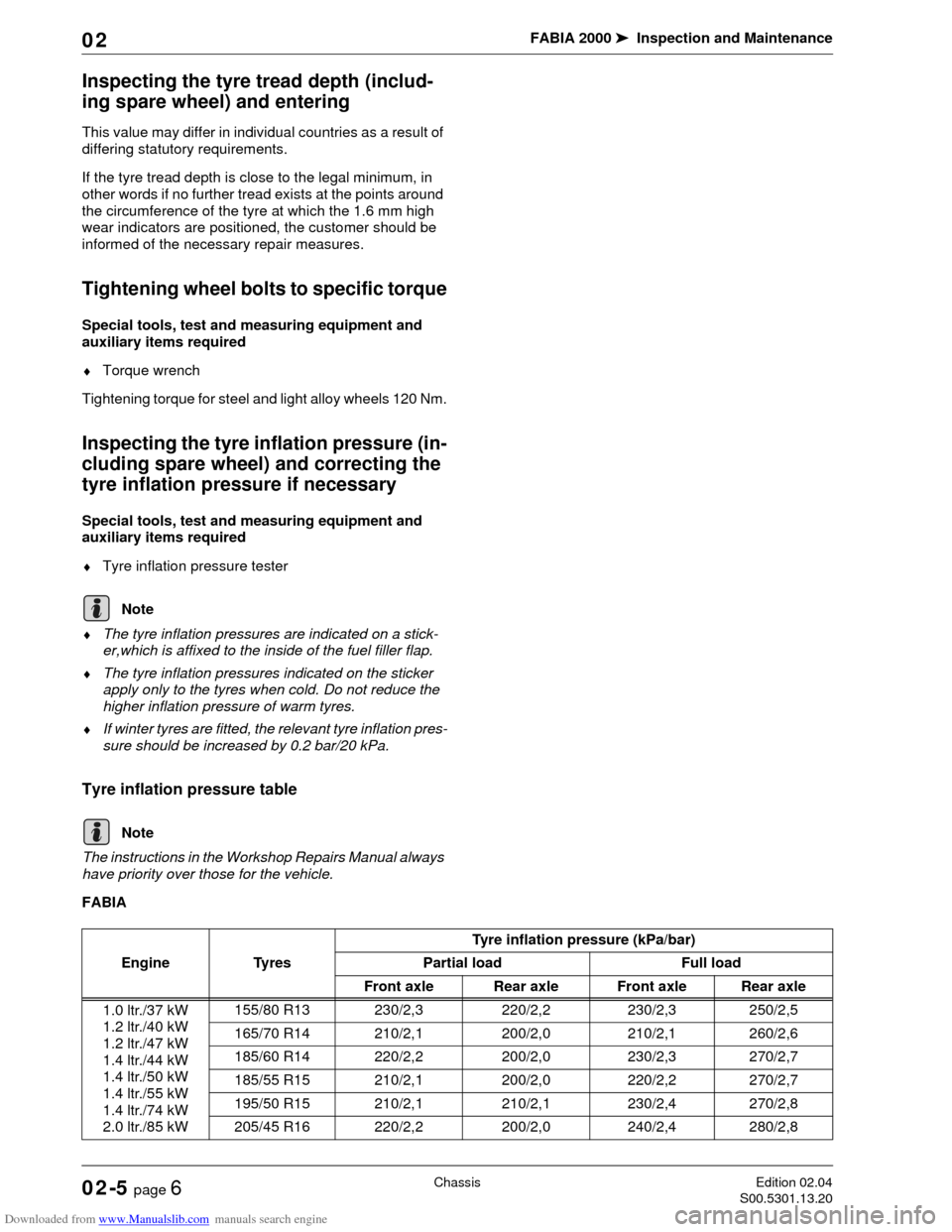
Downloaded from www.Manualslib.com manuals search engine FABIA 2000➤Inspection and Maintenance
ChassisEdition 02.04
S00.5301.13.2002-5 page 6 02
Inspecting the tyre tread depth (includ-
ing spare wheel) and entering
This value may differ in individual countries as a result of
differing statutory requirements.
If the tyre tread depth is close to the legal minimum, in
other words if no further tread exists at the points around
the circumference of the tyre at which the 1.6 mm high
wear indicators are positioned, the customer should be
informed of the necessary repair measures.
Tightening wheel bolts to specific torque
Special tools, test and measuring equipment and
auxiliary items required
♦Torque wrench
Tightening torque for steel and light alloy wheels 120 Nm.
Inspecting the tyre inflation pressure (in-
cluding spare wheel) and correcting the
tyre inflation pressure if necessary
Special tools, test and measuring equipment and
auxiliary items required
♦Tyre inflation pressure tester
♦The tyre inflation pressures are indicated on a stick-
er,which is affixed to the inside of the fuel filler flap.
♦The tyre inflation pressures indicated on the sticker
apply only to the tyres when cold. Do not reduce the
higher inflation pressure of warm tyres.
♦If winter tyres are fitted, the relevant tyre inflation pres-
sure should be increased by 0.2 bar/20 kPa.
Tyre inflation pressure table
The instructions in the Workshop Repairs Manual always
have priority over those for the vehicle.
FABIA
Note
Note
Engine TyresTyre inflation pressure (kPa/bar)
Partial load Full load
Front axle Rear axle Front axle Rear axle
1.0 ltr./37 kW
1.2 ltr./40 kW
1.2 ltr./47 kW
1.4 ltr./44 kW
1.4 ltr./50 kW
1.4 ltr./55 kW
1.4 ltr./74 kW
2.0 ltr./85 kW155/80 R13 230/2,3 220/2,2 230/2,3 250/2,5
165/70 R14 210/2,1 200/2,0 210/2,1 260/2,6
185/60 R14 220/2,2 200/2,0 230/2,3 270/2,7
185/55 R15 210/2,1 200/2,0 220/2,2 270/2,7
195/50 R15 210/2,1 210/2,1 230/2,4 270/2,8
205/45 R16 220/2,2 200/2,0 240/2,4 280/2,8
Page 65 of 86
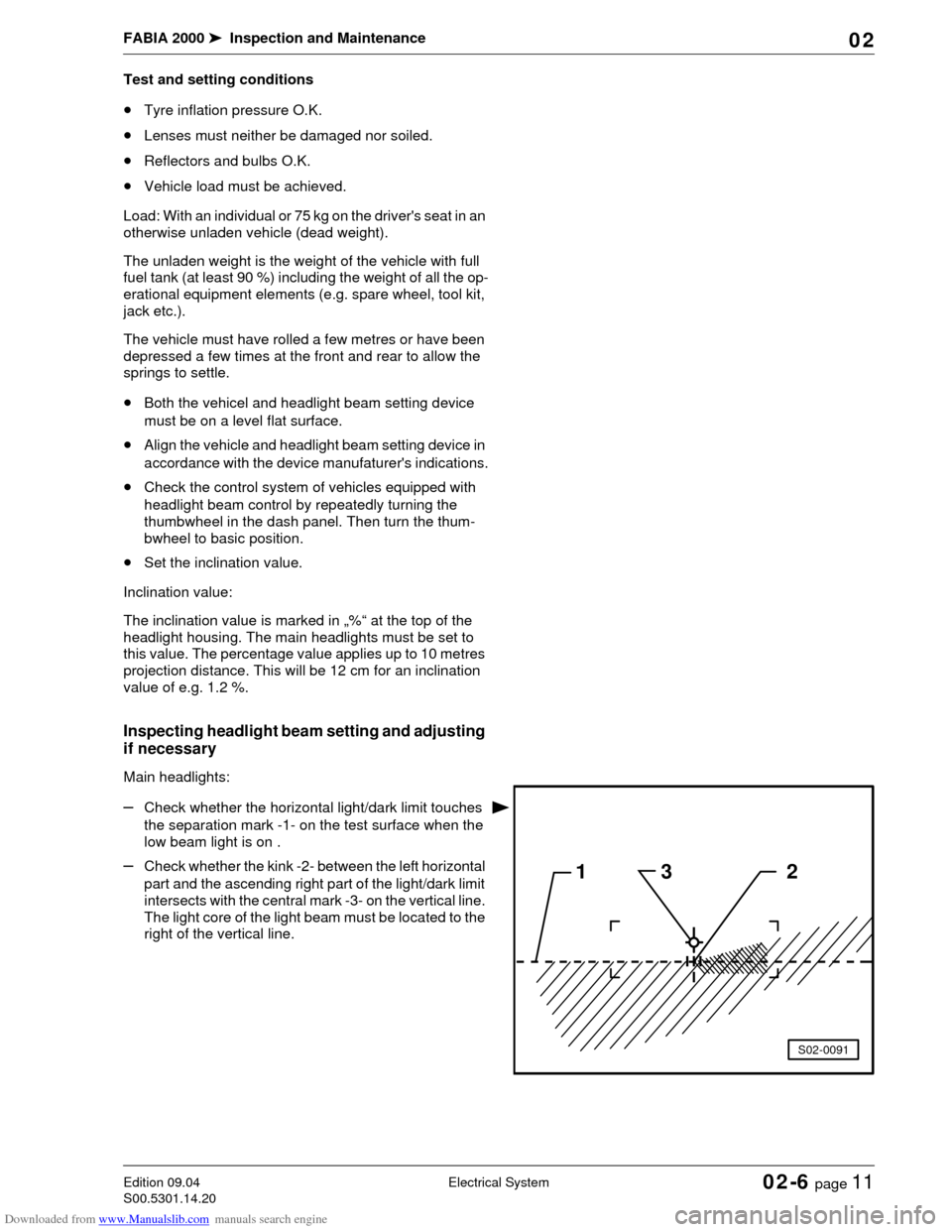
Downloaded from www.Manualslib.com manuals search engine FABIA 2000➤Inspection and Maintenance
Electrical SystemEdition 09.04
S00.5301.14.2002-6 page 11 02
Test and setting conditions
•Tyre inflation pressure O.K.
•Lenses must neither be damaged nor soiled.
•Reflectors and bulbs O.K.
•Vehicle load must be achieved.
Load: With an individual or 75 kg on the driver's seat in an
otherwise unladen vehicle (dead weight).
The unladen weight is the weight of the vehicle with full
fuel tank (at least 90 %) including the weight of all the op-
erational equipment elements (e.g. spare wheel, tool kit,
jack etc.).
The vehicle must have rolled a few metres or have been
depressed a few times at the front and rear to allow the
springs to settle.
•Both the vehicel and headlight beam setting device
must be on a level flat surface.
•Align the vehicle and headlight beam setting device in
accordance with the device manufaturer's indications.
•Check the control system of vehicles equipped with
headlight beam control by repeatedly turning the
thumbwheel in the dash panel. Then turn the thum-
bwheel to basic position.
•Set the inclination value.
Inclination value:
The inclination value is marked in „%“ at the top of the
headlight housing. The main headlights must be set to
this value. The percentage value applies up to 10 metres
projection distance. This will be 12 cm for an inclination
value of e.g. 1.2 %.
Inspecting headlight beam setting and adjusting
if necessary
Main headlights:
–Check whether the horizontal light/dark limit touches
the separation mark -1- on the test surface when the
low beam light is on .
–Check whether the kink -2- between the left horizontal
part and the ascending right part of the light/dark limit
intersects with the central mark -3- on the vertical line.
The light core of the light beam must be located to the
right of the vertical line.132
S02-0091
Page 66 of 86
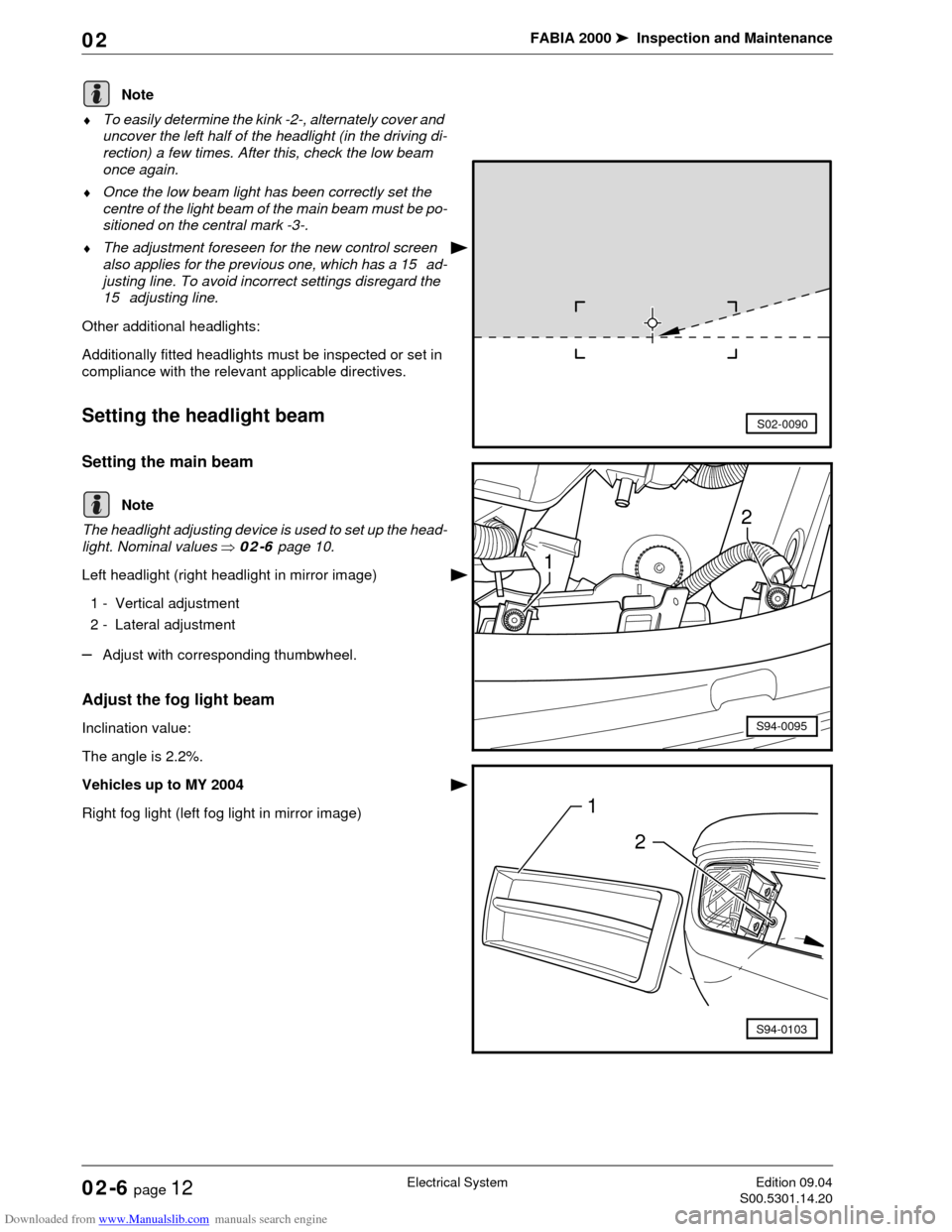
Downloaded from www.Manualslib.com manuals search engine FABIA 2000➤Inspection and Maintenance
Electrical SystemEdition 09.04
S00.5301.14.2002-6 page 12 02
♦To easily determine the kink -2-, alternately cover and
uncover the left half of the headlight (in the driving di-
rection) a few times. After this, check the low beam
once again.
♦Once the low beam light has been correctly set the
centre of the light beam of the main beam must be po-
sitioned on the central mark -3-.
♦The adjustment foreseen for the new control screen
also applies for the previous one, which has a 15 ad-
justing line. To avoid incorrect settings disregard the
15 adjusting line.
Other additional headlights:
Additionally fitted headlights must be inspected or set in
compliance with the relevant applicable directives.
Setting the headlight beam
Setting the main beam
The headlight adjusting device is used to set up the head-
light. Nominal values ⇒02-6 page 10.
Left headlight (right headlight in mirror image)
1 - Vertical adjustment
2 - Lateral adjustment
–Adjust with corresponding thumbwheel.
Adjust the fog light beam
Inclination value:
The angle is 2.2%.
Vehicles up to MY 2004
Right fog light (left fog light in mirror image)
Note
S02-0090
Note2
1
S94-0095
1
2
S94-0103
Page 69 of 86
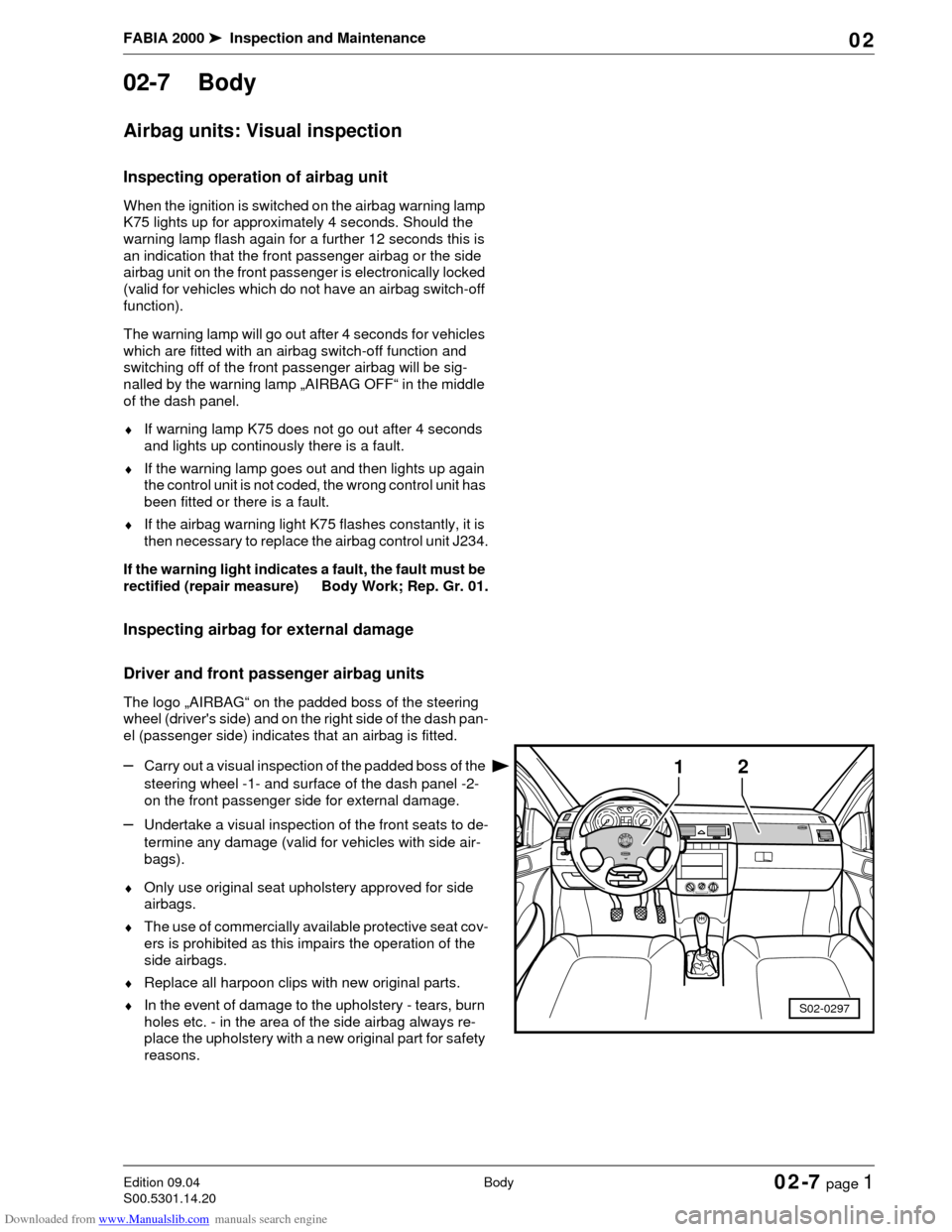
Downloaded from www.Manualslib.com manuals search engine FABIA 2000➤Inspection and Maintenance
BodyEdition 09.04
S00.5301.14.2002-7 page 1 02
02-7 Body
Airbag units: Visual inspection
Inspecting operation of airbag unit
When the ignition is switched on the airbag warning lamp
K75 lights up for approximately 4 seconds. Should the
warning lamp flash again for a further 12 seconds this is
an indication that the front passenger airbag or the side
airbag unit on the front passenger is electronically locked
(valid for vehicles which do not have an airbag switch-off
function).
The warning lamp will go out after 4 seconds for vehicles
which are fitted with an airbag switch-off function and
switching off of the front passenger airbag will be sig-
nalled by the warning lamp „AIRBAG OFF“ in the middle
of the dash panel.
♦If warning lamp K75 does not go out after 4 seconds
and lights up continously there is a fault.
♦If the warning lamp goes out and then lights up again
the control unit is not coded, the wrong control unit has
been fitted or there is a fault.
♦If the airbag warning light K75 flashes constantly, it is
then necessary to replace the airbag control unit J234.
If the warning light indicates a fault, the fault must be
rectified (repair measure) Body Work; Rep. Gr. 01.
Inspecting airbag for external damage
Driver and front passenger airbag units
The logo „AIRBAG“ on the padded boss of the steering
wheel (driver's side) and on the right side of the dash pan-
el (passenger side) indicates that an airbag is fitted.
–Carry out a visual inspection of the padded boss of the
steering wheel -1- and surface of the dash panel -2-
on the front passenger side for external damage.
–Undertake a visual inspection of the front seats to de-
termine any damage (valid for vehicles with side air-
bags).
♦Only use original seat upholstery approved for side
airbags.
♦The use of commercially available protective seat cov-
ers is prohibited as this impairs the operation of the
side airbags.
♦Replace all harpoon clips with new original parts.
♦In the event of damage to the upholstery - tears, burn
holes etc. - in the area of the side airbag always re-
place the upholstery with a new original part for safety
reasons.
1
S02-0297
2
Page 70 of 86
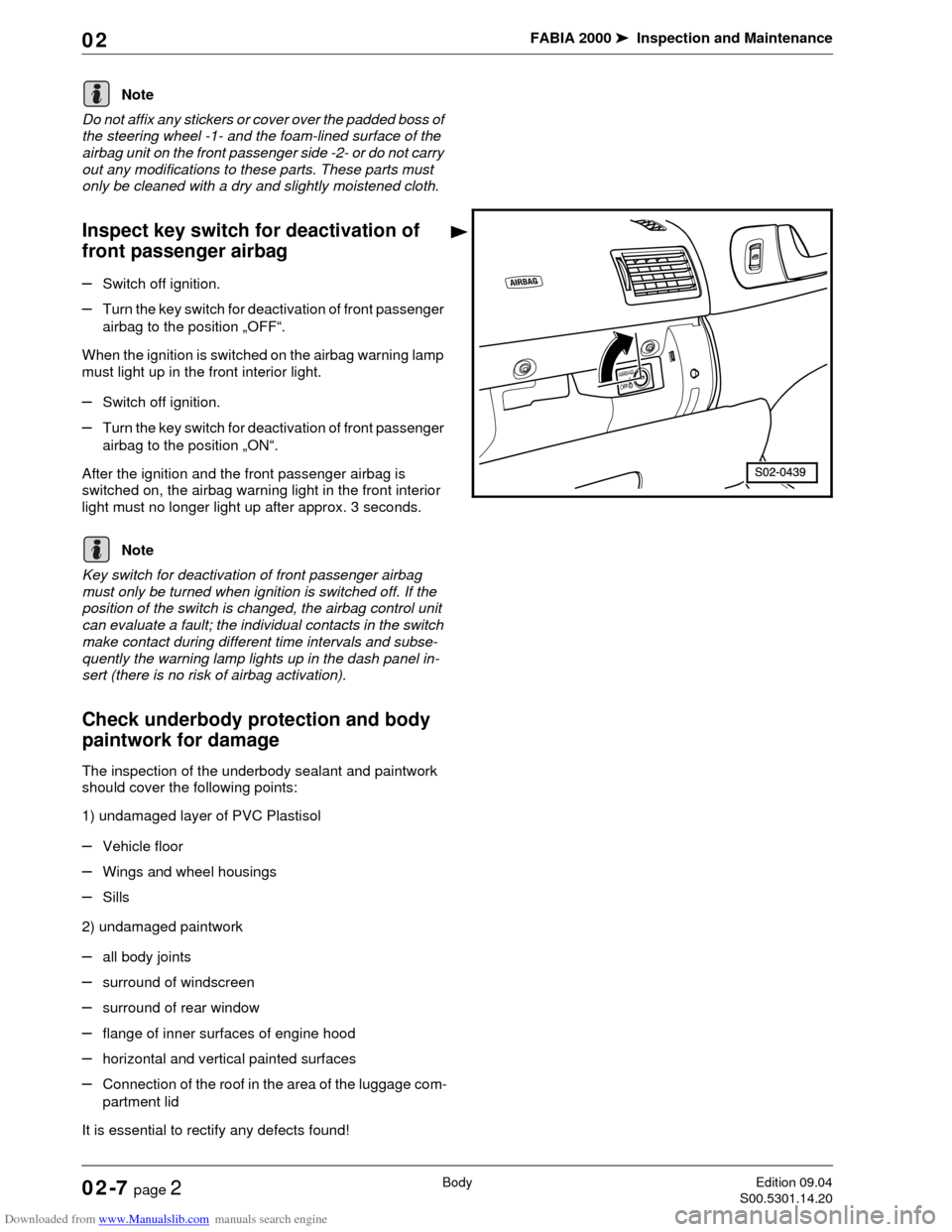
Downloaded from www.Manualslib.com manuals search engine FABIA 2000➤Inspection and Maintenance
BodyEdition 09.04
S00.5301.14.2002-7 page 2 02
Do not affix any stickers or cover over the padded boss of
the steering wheel -1- and the foam-lined surface of the
airbag unit on the front passenger side -2- or do not carry
out any modifications to these parts. These parts must
only be cleaned with a dry and slightly moistened cloth.
Inspect key switch for deactivation of
front passenger airbag
–Switch off ignition.
–Turn the key switch for deactivation of front passenger
airbag to the position „OFF“.
When the ignition is switched on the airbag warning lamp
must light up in the front interior light.
–Switch off ignition.
–Turn the key switch for deactivation of front passenger
airbag to the position „ON“.
After the ignition and the front passenger airbag is
switched on, the airbag warning light in the front interior
light must no longer light up after approx. 3 seconds.
Key switch for deactivation of front passenger airbag
must only be turned when ignition is switched off. If the
position of the switch is changed, the airbag control unit
can evaluate a fault; the individual contacts in the switch
make contact during different time intervals and subse-
quently the warning lamp lights up in the dash panel in-
sert (there is no risk of airbag activation).
Check underbody protection and body
paintwork for damage
The inspection of the underbody sealant and paintwork
should cover the following points:
1) undamaged layer of PVC Plastisol
–Vehicle floor
–Wings and wheel housings
–Sills
2) undamaged paintwork
–all body joints
–surround of windscreen
–surround of rear window
–flange of inner surfaces of engine hood
–horizontal and vertical painted surfaces
–Connection of the roof in the area of the luggage com-
partment lid
It is essential to rectify any defects found!
Note
Note
Page 74 of 86
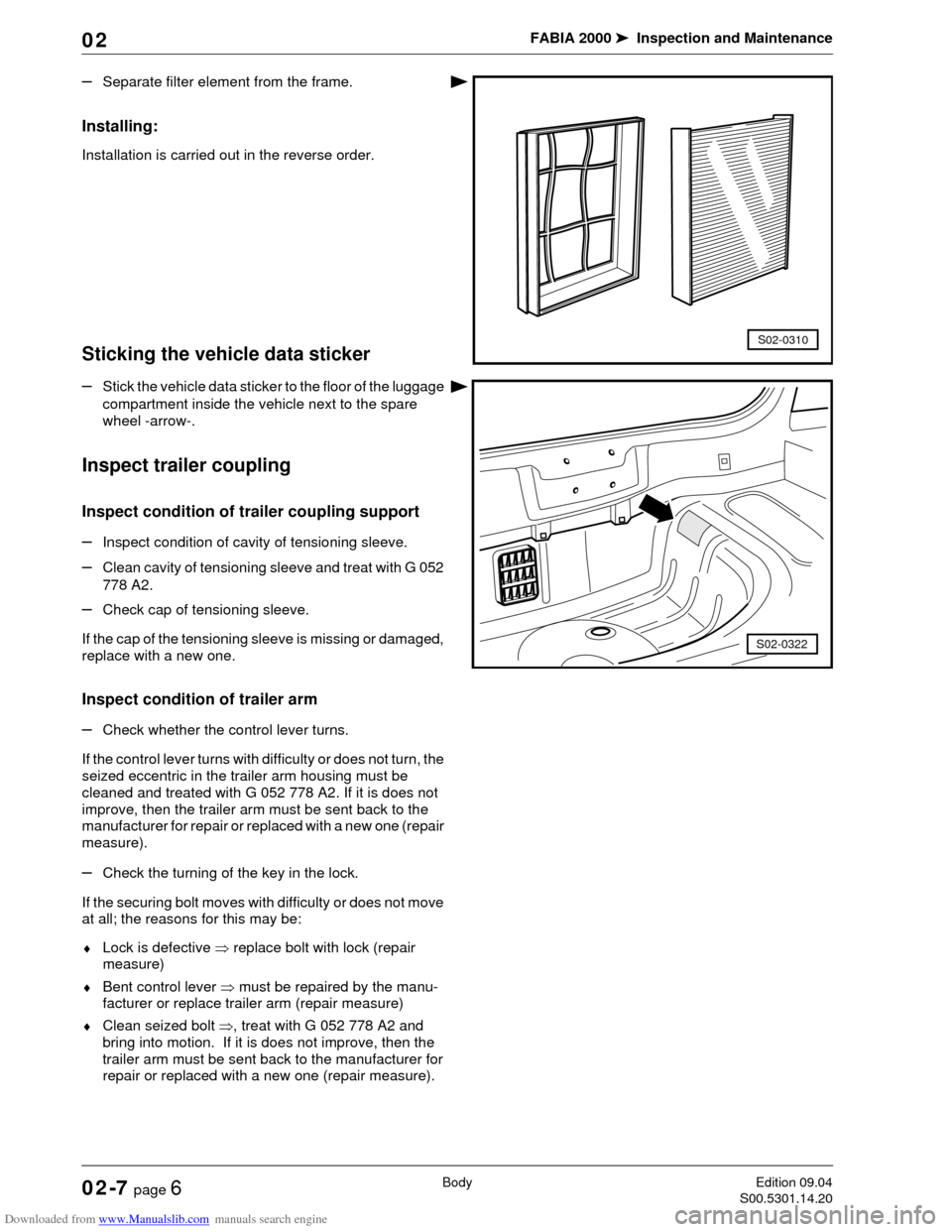
Downloaded from www.Manualslib.com manuals search engine FABIA 2000➤Inspection and Maintenance
BodyEdition 09.04
S00.5301.14.2002-7 page 6 02
–Separate filter element from the frame.
Installing:
Installation is carried out in the reverse order.
Sticking the vehicle data sticker
–Stick the vehicle data sticker to the floor of the luggage
compartment inside the vehicle next to the spare
wheel -arrow-.
Inspect trailer coupling
Inspect condition of trailer coupling support
–Inspect condition of cavity of tensioning sleeve.
–Clean cavity of tensioning sleeve and treat with G 052
778 A2.
–Check cap of tensioning sleeve.
If the cap of the tensioning sleeve is missing or damaged,
replace with a new one.
Inspect condition of trailer arm
–Check whether the control lever turns.
If the control lever turns with difficulty or does not turn, the
seized eccentric in the trailer arm housing must be
cleaned and treated with G 052 778 A2. If it is does not
improve, then the trailer arm must be sent back to the
manufacturer for repair or replaced with a new one (repair
measure).
–Check the turning of the key in the lock.
If the securing bolt moves with difficulty or does not move
at all; the reasons for this may be:
♦Lock is defective ⇒ replace bolt with lock (repair
measure)
♦Bent control lever ⇒ must be repaired by the manu-
facturer or replace trailer arm (repair measure)
♦Clean seized bolt ⇒, treat with G 052 778 A2 and
bring into motion. If it is does not improve, then the
trailer arm must be sent back to the manufacturer for
repair or replaced with a new one (repair measure).
S02-0310
S02-0322